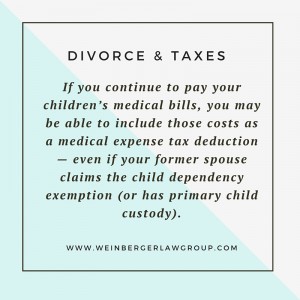Filing Tax Returns After Separation or Divorce, Part 1
If you are newly separated or divorced, filing a federal tax return can present a host of new and confusing options and scenarios. In honor of the approaching April 15th tax filing deadline, this month we will be sharing some of this valuable information with you in a three-part series discussing tax issues and divorce.
Today we are going to talk about filing status, and its potential impact on exemptions, credits and deductions. In Part 2, we’ll touch on income tax issues in alimony and child support, and in Part 3, we’ll address some of the tax implications of dividing property in divorce.
Choosing a Filing Status
Taxpayers who finalize their divorce by the end of the year have to choose either single or head of household filing status. If your divorce was still in progress at year-end, you and your spouse can choose to file a joint return, or you can file as married but filing separately. In the great majority of cases, filing a joint return will result in lower taxes. Many credits and deductions, including the earned income credit, the American opportunity and lifetime learning credits, and the tuition and fees and student loan interest deductions are not available to married couples filing separately. Depending on the circumstances, the child and dependent care credit, and any credits or exclusions available for adoption expenses may also be unavailable. Credits and deductions that can be dramatically reduced include the child tax credit, the retirement savings contributions credit, the deduction for personal exemptions, and all itemized deductions.
In spite of this daunting list, there are still a few situations where taxes will end up lower on a separate return. Many people going through divorce also prefer to file separately from their soon-to-be-ex regardless of the likelihood of higher taxes, because they simply want to take an additional step toward financial and legal independence. Filing a joint return results in joint liability for both filers, while filing separate returns does not.
Whether your divorce is final or not, if you can qualify to file as head of household, you will reap the benefits of a bigger standard deduction and lower tax brackets. To do this, you must be either unmarried or “considered unmarried” on the last day of the year; you must have paid more than half the cost of keeping up a home for that year; and you must have a “qualifying dependent.” If you have not yet finalized your divorce, you can still be “considered unmarried,” as long as you file a separate return, maintain a residence separate from your spouse for at least the last six months of the year, and have a child who “qualifies” as a dependent. The child must have lived in your home for more than half the year (not counting temporary absences for things like college attendance); must be under 19, or a full-time student under 24, and also younger than the taxpayer (or permanently and totally disabled regardless of age); must not have provided more than 50% of his or her own support for the year; and must not have filed a joint return with a spouse that shows tax liability for the same year. In addition to a taxpayer’s own children, certain closely-related children can qualify.
Only one taxpayer can claim head of household status by means of the same child. Due to the residence requirements, this will usually be the custodial parent, or the parent of primary residence. Parents who share custody of multiple children may both be able to qualify by agreeing that one child will live slightly more than half the time with one parent and another child will live slightly more than half the time with the other. If you choose to do this, however, it is important to enter into an appropriately worded custody agreement and also keep careful records of the children’s actual time in each household.
Waiver of Dependent Exemption
For the 2015 tax year, taxpayers can claim an exemption of $4,000 for each dependent on a return. The custodial parent or parent of primary residence can either claim a qualifying child or assign the exemption to the other parent. In the latter case, both parents must complete IRS Form 8332, which the non-custodial parent then attaches to the tax return. It is important to understand that only the exemption for a qualifying dependent can be assigned, not the right to claim head of household status.
Sometimes separated or divorced parents agree that each parent will claim a child as a dependent in alternating years. This may sound like the most equitable solution, but parents should first consider all of the actual financial ramifications. Claiming a child as a dependent is not only different from claiming head of household status, it is also different from claiming certain other tax benefits based on custodial parent status.
Only the parent who actually claims a child as a dependent on the tax return has the right to claim any applicable child tax credits or any higher education credits or deductions for which the child may qualify. Even if the custodial parent signs over the right to claim the dependent to the non-custodial parent, however, the custodial parent retains the right to claim any available earned income credit based on having the qualifying child in the home, any child care tax credits for children 12 and under, and any exclusion for dependent care benefits.
For more detailed information, see IRS Publication 501, Exemptions, Standard Deduction, and Filing Information, or consult with your financial advisor. If you are interested in talking to an attorneys about negotiating tax-friendly Marital Settlement Agreements, contact us for an initial consultation.
Do you have questions about how issues in your divorce could impact your taxes later on? Our attorneys can help. Please contact us to schedule your initial confidential consultation.



